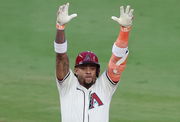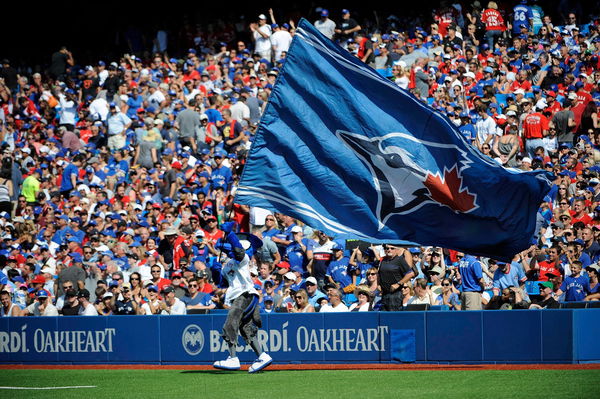
Imago
Imago

Imago
Imago
If you have ever been to a Toronto Blue Jays game, you cannot miss him. Ace is the seven-foot-tall, friendly blue jay who defines the team’s spirit and pumps up the crowd at Rogers Center. You see him dancing on the dugout, leading cheers, giving high-fives, and posing for selfies with almost everyone. In a simple sentence, he is one of the most beloved faces of the franchise, and if we lent the words of one of his performers, he is the “host of the party.”
Watch What’s Trending Now!
But have you ever wondered where this popular bird comes from that makes every fan feel welcome at the Rogers Center? Or, why is he named Ace? Or, how much does he make for being the life of the party? Yes and no, right? Then you’re in the right place.. Let’s dive into the story behind the beloved Blue Jay.
ADVERTISEMENT
What’s the Story Behind the Blue Jays Mascot “Ace”?
Firstly, the name “Ace” is derived from pure Baseball terminology. We call the leader of the pitching rotation an Ace. He is the team’s best starting pitcher and the one guy you trust most in a big game.
And it is precisely the reason for choosing the mascot’s name, which perfectly fits the team’s identity. But here’s the catch: the name wasn’t chosen by the team; it was chosen by a high school student, A. McConnel, in a fan-naming contest.
Top Stories
Blue Jays Forced to Make Heartbreaking Trades as Ketel Marte Chase Triggers Bold D-Backs Demand: MLB Rumors

Shohei Ohtani Fear Fades as 36-Year-Old Teammate Terrifies MLB Managers Amid Rising Dodgers Dominance

“We’re the Pittsburgh Pirates”- Mets Radio Host Criticizes Steve Cohen for Duping Queens Fans After Dismantling the Core

ESPN Insider Loses Faith in David Stearns After Pete Alonso- Jorge Polanco “Headscratcher” Leaves Juan Soto & Mets Vulnerable

Blue Jays Handed Blunt Reality Check on Offseason Plans as Kyle Tucker–Bo Bichette Chase Heats Up

Ace was first introduced in 2000, but like now, he was not alone then. He was part of a male-female duo with a mascot named “Diamond.” The Blue Jays held a “Name the Mascots Contest”; McConnel first submitted the winning names, but before that, the team’s internal names for the duo were “Slider” and “Curveball.”
ADVERTISEMENT
The duo of Ace and Diamond did not last long, and Diamond was retired by the organization after the 2003 season. In this short tenure, Angelina Milanovic, Larissa Bathgate, and Amanda Barker played the role of “Diamond.” This left Ace as the team’s sole mascot, who later underwent a major redesign in 2012 as part of the team’s rebrand to its classic look, with his beak turning from grey to blue and his legs changing from black to grey.
But have you ever wondered why the franchise chose to introduce them after 23 years of establishment? No! They didn’t. Ace wasn’t the Blue Jays’ first mascot; it was BJ Birdy. So,
ADVERTISEMENT

Imago
Imago
When Did Ace Replace BJ Birdy and Why the Change?
The Blue Jays’ first original mascot was BJ Birdy, a beloved but often chaotic character who served as the team’s mascot for 20 years, from 1979 to 1999, and was played by only one man, Kevin Shanahan, for the whole time.
ADVERTISEMENT
Shanahan was famous for his dedication. There’s a report that he once lost several toes in an accident, but missed only one game in 1991. In some cases, he was also a troublemaker, like in 1989, when he made noise at the Dodgers’ dugout and got himself ejected. And four years later, he got ejected from another game against the Minnesota Twins after arguing with the umpire and making offensive gestures towards him.
So why did the team drop such a famous mascot? There’s no clear written statement. But there are speculations that Shanahan was due for a huge raise. And some even say, it was a major business decision because the Blue Jays organization did not own the copyright to the BJ Birdy character; Kevin Shanahan did, and this was limiting the team’s ability to sell merchandise. So, when the new ownership (Rogers Communications) took over, they wanted a mascot that they owned. That’s why they have created Ace and Diamond. And it allowed them to launch a modern mascot program for a new generation of fans.
And now, the main question,
ADVERTISEMENT
How Much Does Ace the Blue Jays Mascot Make?
The most recent estimate for Ace’s salary is $65,000 per year. This is a full-time, professional role, unlike the original female mascot, Diamond, who was paid about $100 per game. And while $65,000 is a good salary, it is surprisingly low in the world of professional mascots, and in fact it is one of the lower salaries in Major League Baseball, as other top-tier mascots, like Boston’s Wally the Green Monster, reportedly earn salaries closer to $250,000 and Rocky the Mountain Lion of the NBA’s Denver Nuggets reportedly earns a $625,000, highest in all of sports.
Mascots became a staple of baseball entertainment in the late 1970s, starting with the Phillies’ Phillie Phanatic in 1978, which showed how a mascot could boost fan energy and team spirit.
ADVERTISEMENT
In Canada, Ace joined a proud lineup that includes Carlton the Bear of the Maple Leafs and The Raptor of the Raptors, each a symbol of their team’s identity. His arrival at the Rogers Center (then SkyDome) in 2000 reflected a new era of fan-focused entertainment and community connection in Toronto sports.
And, What Does Ace Do to Earn His Salary?
The person inside the suit earns every penny of that salary. Because the job is very demanding and a year-round role where Ace must perform at all 81 home games. And in those games, he dances on the dugouts, leads cheers, takes selfies with fans, gives high fives, participates in on-field promotions, and whatnot! He even assists with the ceremonial first pitch. So, basically, he is the team’s full-time community ambassador.
ADVERTISEMENT
And the job does not end even when the game is over. The 12-month community ambassador appears at hundreds of charity functions, school visits, corporate events, and the team even has an official portal to book Ace for private parties. It’s really a very tough role where the performer also shoots commercials, promotional videos, and photos for the team’s marketing. And the current performer has reportedly suffered a torn AC joint and even a fractured spine from the job.
What is your favorite memory with Ace at a Blue Jays game? Share it in the comments below!
ADVERTISEMENT
ADVERTISEMENT
ADVERTISEMENT

